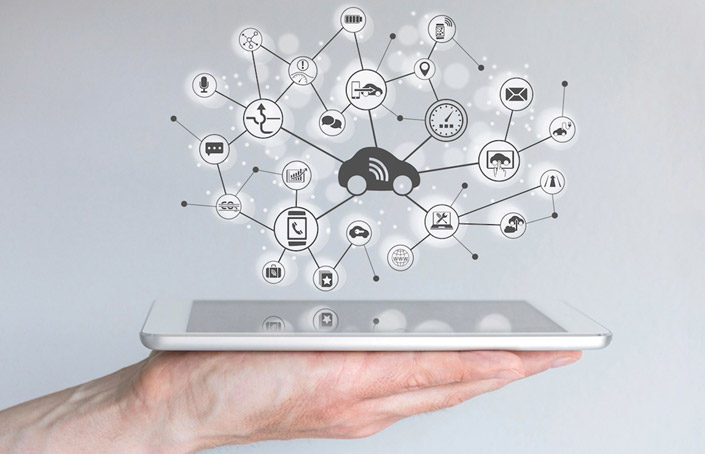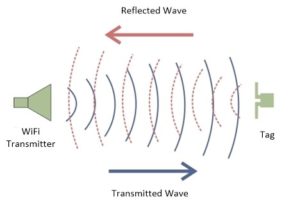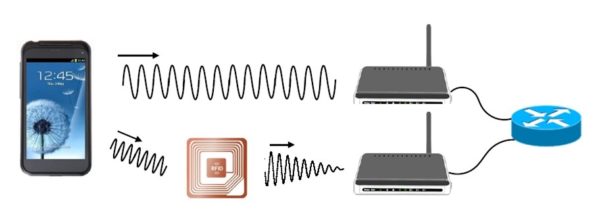
Thanks to HitchHike, a low power tag reflects existing 802.11b transmissions from a commodity WiFi transmitter, and the backscattered signals can then be decoded as a standard WiFi packet by a commodity 802.11b receiver.
WiFi is well-known to be power-hungry. Commodity WiFi radios consume several hundreds of milliwatts of power. Due to its high power consumption, it is hard to continuously use WiFi for Internet connection. One research group in Stanford University set out to address this problem by making WiFi transmission not only power efficient, but extremely so. The new radio they designed, called HitchHike, consumes a mere 33 microwatts—10,000x lower than existing WiFis. Such “WiFi-ish” radio enables WiFi transmission on a battery-free device, and therefore has the potential to benefit millions (if not billion) of devices across the Internet of Things. In fact, HitchHike’s power could be sourced by energy harvesting alone.
HitchHike achieves such low-power WiFi transmission by leveraging a technology called backscatter. The key idea of backscatter is signal reflection. When a device wants to transmit data over the air, instead of directly generating the wireless signal, a device actually reflects a wireless signal that is produced by another entity. Since signal reflection consumes three to four orders magnitude less power compared to direct wireless signal transmission, backscatter enables data transmission at extremely low power. This technology has been used in commercial products like passive RFID. Traditional backscatter systems like RFID, however, require specialized hardware to generate the excitation RF signals that backscatter radios can reflect, as well as to decode the backscattered signals. HitchHike enables this capability when talking to a commercial WiFi Access Point, with no additional hardware.

A backscatter tag communicates by modulating the scattered electromagnetic wave incident from the transmitter. The scattered wave is modulated by changing the electrical impedance presented to the tag antenna. A passive backscatter tag receives the power needed to operate from the wave incident from the transmitter.
While recent research such as WiFi backscatter, BackFi, and Passive WiFi, has reduced the need for specialized hardware, these systems are still not self-sufficient. Passive WiFi, for example, can decode backscattered signal using standard WiFi radios. However, it still requires a dedicated continuous wave signal generator as the excitation RF signal source. BackFi needs a proprietary full-duplex hardware add-on to WiFi radios to enable backscatter communication. Inter-Technology Backscatter is a system that enables backscatter communication from a commercial Bluetooth radio to a commercial WiFi radio. Despite its novelty, it does not enable backscatter communication among WiFi radios. Consequently, a backscatter system that can be deployed using commodity WiFi radios on access points, smartphones, watches and tablets, does not exist. HitchHike is, therefore, the first backscatter communication system that works using only commodity 802.11b WiFi devices for both generating the RF excitation signal as well as decoding the backscattered signal.
The enabling technique manifested in HitchHike is called codeword translation. Pengyu Zhang at Stanford found that a WiFi signal is produced using a fixed set of codewords. In other words, a WiFi signal is simply determined by a specific binary sequence which is the codeword in a codebook. Zhang found that one codeword in the codebook can be transformed to another by performing phase modifications. For example, 1 Mbps 802.11b transmission uses only two codewords, code0 and code1. Data zero and one are encoded as code0 and code1, respectively. The only difference between the two codewords is a 180° phase offset, which indicates whether data zero or one is transmitted.
Inspired by this observation, Zhang designed a special backscatter tag, which is able to reflect a WiFi signal from one WiFi transmitter to a WiFi Access Point. During the signal reflection, the tag embeds its information by performing or not performing codeword translation. For example, when the tag wants to transmit data one, the reflected codeword is different from the codeword in the excitation WiFi signal. When the tag wants to transmit data zero, the reflected codeword is the same as the codeword in the excitation WiFi signal.

Prototype circuit block diagram.
HitchHike’s deployment is best explained via the example in Figure 1. The excitation device is a smartphone with a standard WiFi radio. The smartphone transmits an 802.11b packet to the first AP to which it is connected on Channel 1. To backscatter, the tag receives the WiFi packet, frequency shifts it to Channel 6, modulates its information and then reflects the WiFi signal. The second AP, which is tuned to listen on Channel 6, then receives and decodes the backscatter packet as a standard WiFi packet. Pretty simple. This channel-shifting scheme eliminates interference between the original signal and the backscattered data stream coming from the HitchHike tag.

HitchHike enables backscatter communication between commodity 802.11b WiFi radios.
The most important part of the HitchHike technology is that the reflected signal is still a valid WiFi signal. Therefore, it can use a commodity WiFi Access point to decode the reflected signal and extract the tag information. Secondly, HitchHike does not waste spectrum; it piggybacks backscattered signals on WiFi packets that are being used for productive communication. Hence, HitchHike can be efficiently deployed with current WiFi infrastructure and unlicensed spectrum.
The video, above, demonstrates the use of an off-the-shelf Intel WiFi transmitter (black box on right) with an Apple MacBook Pro (left) left as a WiFi receiver. The object in the middle is the HitchHike device prototype, which is connected to an electrocardiogram (heart rate) sensor. HitchHike samples the electrocardiogram data, and piggybacks (hitchhikes) it on the WiFi signal from the Intel WiFi router. The Apple laptop receives, extracts, and displays the piggybacked signal in real time.
Zhang further demonstrated that HitchHike can be used for transmitting biometric data at extremely low power. In this demo, Zhang connected an ECG (electrocardiogram) sensor to the HitchHike radio. The ECG sensing platform samples the ECG signal and backscatters the ECG data from an Intel 5300 WiFi transmitter to an Apple Macbook Pro. The communication distance between the tag and the receiver can be as far as 40m, and with a data rate of nearly 300kbps at 10m.
This novel technology has the potential of enabling, if not transforming, myriad applications in the Internet of Things domain, and certainly in mobile health sensing. To learn more about it, download the paper.
About Pengyu Zhang, PhD
Pengyu Zhang is a postdoc researcher at Stanford. His research focuses on mobile computing and low-power wireless sensing. He obtained his Ph.D. from UMass Amherst and his bachelor from Tsinghua University. He received the best paper runner-up award at MobiCom 2014, the honorable mention award at UbiComp 2016, the 2016 ACM SIGMOBILE Doctoral Dissertation Award, and the 2016 Outstanding Doctoral Dissertation Award at UMass Amherst.


